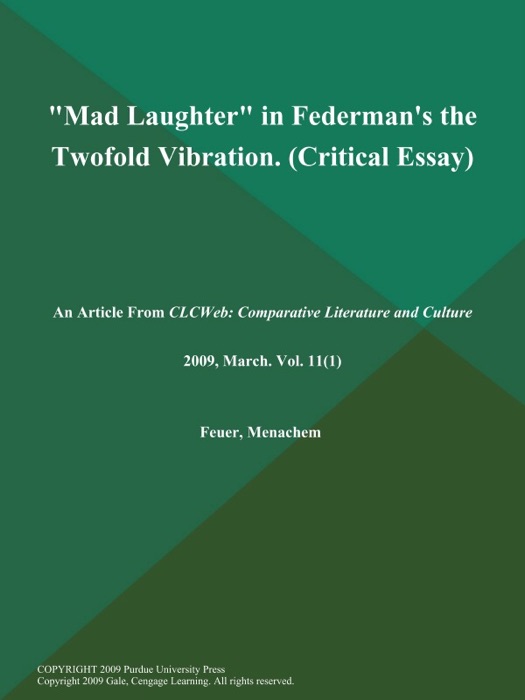[Download] "Mad Laughter in Federman's the Twofold Vibration (Critical Essay)" by CLCWeb: Comparative Literature and Culture # eBook PDF Kindle ePub Free

eBook details
- Title: Mad Laughter in Federman's the Twofold Vibration (Critical Essay)
- Author : CLCWeb: Comparative Literature and Culture
- Release Date : January 01, 2009
- Genre: Language Arts & Disciplines,Books,Professional & Technical,Education,
- Pages : * pages
- Size : 93 KB
Description
Following Theodor Adorno that "writing poetry after Auschwitz is barbaric" (34) given the unspeakable inhumanity of the Shoah, certainly comedy and laughter would have no place in Holocaust art, in literature, film, or drama, and, at best, only tragedy seems appropriate. However, Lawrence Langer, in his Literature and the Holocaust Imagination, argues that neither modes are adequate and claims that in response to this failure of traditional representation post-Holocaust poets and writers such as Paul Celan, Elie Wiesel, and Jerzy Kosinski created a new genre called the "art of atrocity" (Langer 30) to represent the Holocaust aesthetically. Although Langer is correct in arguing that these authors started a new trend in literature, poetry, and drama by creating a new genre, neither their work nor his own, with its insistence that tragedy and comedy are inadequate, has kept writers and filmmakers from drawing on tragedy or comedy in their post-Holocaust works. Indeed, some of the most successful post-Holocaust (i.e., fictional texts about the Holocaust) books, films, and plays such as Mel Brooks's The Producers (musical 1968), Lina Wertmuller's The Seven Beauties (film 1975), Roberto Benigni's Life is Beautiful (film 1997), Michael Chabon's The Amazing Adventures of Kavalier & Clay (novel 2000), or Jonathan Safran Foer's Everything is Illuminated (novel 2003, film 2005)--to list just a few--draw heavily on comedy. But of all these works, Life is Beautiful was the only one to receive criticism because of its use of comedy. While a number of scholars and critics chimed in with their polemics against the use of comedy in this film, Sander L. Gilman, in his article "Is Life Beautiful? Can the Shoah be Funny?" has provided convincing arguments in this regard. Nonetheless, he does not insist that all forms of comedy are inadequate. Using Jurek Becker's novel Jacob the Liar--which was also made into a film starring Robin Williams--Gilman argues that this novel "makes it possible to use the elicitation of laughter as a means of representing the unrepresentable, not only of the Shoah, but the randomness of life" (304). He adds that the laughter solicited by this novel "doesn't bring resolution; rather, it brings a sense of unease about the Shoah ... a promise that there are no accidents, that at the end of the comedy the gods in the machine will arrive to resolve the action and rescue those in danger" (304). What Gilman implies in his argument is that laughter, when it is deeply unsettling, can go against the nature of the comic mode which lies, specifically, in the "promise that there are no accidents." Beside Becker's Jacob the Liar, there are a few other post-Holocaust novels which make use of unsettling aspects of laughter in the aesthetic representation of the Holocaust. This Way to The Gas Ladies and Gentlemen by Tadeusz Borowski and Jakov Lind's Soul of Wood are quite exemplary in this regard. But in comparison to these notable works, which are preoccupied with ironic laughter, the post-Holocaust fiction of Raymond Federman is quite remarkable. It is not simply an example of an unsettling form of ironic laughter, as the above works surely are; it is also an exploration of a different form of laughter, one which traverses the fine line between irony and the humor that attends self-reflexive/ referential textuality. The former type of irony, which is moral and historical in nature, is challenged by the latter form of humor, which effaces the seriousness of morality at the heart of traditional irony and satire. The laughter in Federman's novels happens between these two extremes. In his novel The Twofold Vibration he calls this laughter "mad laughter" and in his most recent novel, Aunt Rachel's Fur," sad laughter." Both forms of laughter are certainly not exclusive of each other. Nonetheless, they do address a few very important questions to postmodern post-Holocaust representation. Can a self-reflexive/referential text be said